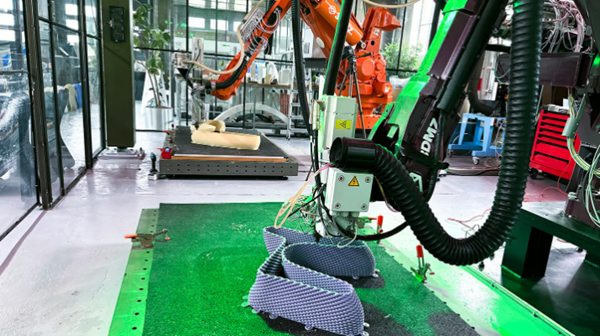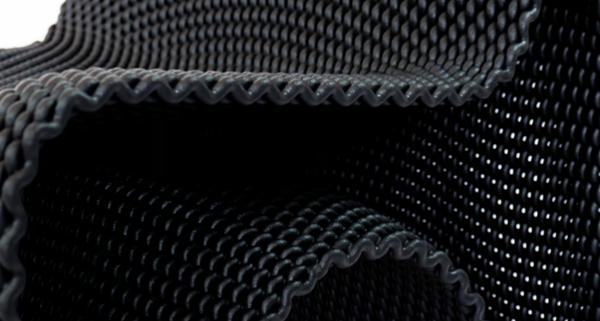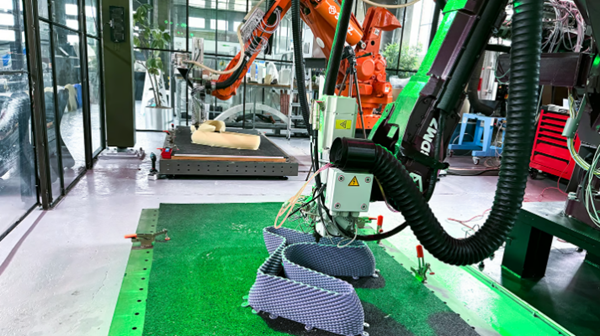This itemwill present you with a greatBasic design techniques for 3D printing, covering key aspects such as choosing the right materials, optimizing print orientation, and refining designs for best results. Whether you’re exploring large-scale 3D printing for the first time or want to improve your existing workflow, you’ll find guidance.
A,what is a large scale3D printing?


picture1:Haarlem, NetherlandsThe 3D Makers Zone robotic arm produces large-scale 3D prints (Source: 3D Makers Zone)
on a large scale3D printing, often called large format additive manufacturing (LFAM), involves systems capable of producing parts of any size larger than 1 meter (3 feet).
Although there are various techniques used to produce parts at this scale, including fused deposition modeling(FDM), laser powder bed fusion (LPBF), electric arc additive manufacturing (WAAM), and some resin technologies, but this guide focuses on robotic arm extrusion-based methods used in industries such as construction, automotive, furniture and large-scale art. projects. Rather than using standard slicing software, these printers feature their own unique toolpath generation system.
Robotic arm3D printers are very different from desktop 3D printers, not only in their size, but also in their technical complexity, material handling and overall workflow. In fact, there is a common misconception that parts and models can simply be scaled for use in LFMA. It’s like a home cook versus a restaurant chef: your equipment, materials, and processes need to be completely different.
The rapid growth of LFAM is driven by technological progress and market demand. Modern large format printers can process a variety of materials beyond standard thermoplastics, including concrete, composites and fiber-reinforced plastics. The ability to manufacture larger functional parts at scale opens up new application possibilities, providing speed, customization and sustainable solutions in everything from construction to manufacturing. Projects like custom building structures and automotive prototypes are just the beginning of what LFAM can achieve.
Despite advances in machines, materials and software,One of the obstacles to wider adoption of LFAM is how its parts are designed. Here, I’ll walk you through the design strategies, material selections, and workflow optimizations needed to provide practical guidance for designers transitioning from small-scale to large-format printing.
two,The 10 most important considerations in LFAM


picture2:Haarlem, NetherlandsThe 3D Makers Zone robotic arm produces large-scale 3D prints (Source: 3D Makers Zone)
Now that you know the large formatSome examples of the widespread use of 3D printing, now it’s time to see how it’s done, and it all starts with design.
If you are already interested in desktop sizeOnce you know something about 3D printing design, the first step toward upgrading to large sizes is forgetting most of what you already know. Large formats require a change in mindset, with more emphasis on material selection and print direction, to name just a few key areas.
Here are perhaps the top ten differences between large-scale design and small-scale design and why they matter.
Consider nozzle size when designing
Nozzle size plays a vital role in determining the overall quality and fastness of large format printing. When designing, it may be helpful to consider the diameter of the nozzle and create a wall thickness that is a multiple of that size (for example, if using2mm nozzle, wall thickness should be 4mm, 6mm or 8mm). Nozzle sizes in LFAM can vary greatly, ranging from 2mm to 24mm. Also make sure that items close to each other are almost touching but not overlapping to avoid material buildup. Considering nozzle size when planning your design results in stronger, cleaner prints and fewer technical issues.
Master adaptive layer height and print speed
When designing a large-scale print, it is crucial to balance print speed and detail. Greater floor height (4mm) can significantly reduce print times, but may sacrifice fine detail, result in rougher surfaces or parts designed to require post-print milling. On the other hand, smaller layer heights (1-2mm) provide finer details but significantly increase printing time. One approach is to use adaptive layer heights, in which larger layers are applied to less detailed areas and smaller layers to complex parts. This technology allows you to speed up the process without compromising the all-important quality.


picture3:Swedish kayak manufacturerMelker printed functional prototypes in 3D from waste injected into wood (Source: Melker, Sweden)
Avoid pliable materials
Large-scale printing requires strong materials, especially when producing functional or structural parts. Reinforcement materials, such as fiberglass-infused polymers, provide the strength and stability needed to prevent problems such as buckling or buckling. For non-structural components or prototypes,Standard materials like PLA may be sufficient, but can be very fragile. Sustainability should always be considered, so choose recyclable, reusable or eco-friendly materials whenever possible.
Simple support may not be enough
asWhen LFAM scales up its design, the structure must support much greater weight than at a smaller scale. Walls that work well on small printers may warp under the added pressure of larger prints. A good rule of thumb is to have walls at least 5-10mm thick, depending on the material. You can also add ribs and gussets to reinforce areas without adding too much weight.


picture4:Haarlem, NetherlandsThe 3D Makers Zone robotic arm produces large-scale 3D prints (Source: 3D Makers Zone)
Rethink print orientation
existIn LFAM, orientation is more important than in small-scale 3D printing, because large-scale printing generally requires more support structures. Minimizing overhangs and strategically rotating models can reduce the need for supports, which consume time and materials. Keep overhang angles below 45 degrees and design self-supporting elements such as chamfers to simplify printing and minimize post-processing.
Robotic armVariable-angle 3D printers and print beds can also allow you to start printing in one direction and then adjust it to another angle.
Designed differently to speed up post-processing
existIn LFAM, the support structure must be designed to be both solid and easily removable. Use grid-shaped supports to effectively support components while being lightweight. Make sure the media is positioned carefully so that it can be easily removed without damaging the print. This is especially important for large prints, where manual disassembly can be time-consuming and laborious. Ultimately, however, the best designs do not require support structures or are integrated into the design.
Be Aware of the Pitfalls of Heating and Cooling
Large-scale prints are more likely to warp due to uneven cooling. The larger the object, the more important it is to maintain consistent thermal conditions throughout the process. Avoid using large flat surfaces in your design and strive for uniform wall thickness to reduce thermal stress. Printing in a heated chamber also helps maintain consistent temperatures and avoids cooling-related distortions. To improve adhesion, use a heated bed and apply spray adhesive, tape, or a textured surface to the build board. For larger prints, adding edges or rafts can also help increase the contact area with the bed, reducing the risk of lifting.
CAD software struggles to handle large format designs
Designers also need to be aware of device limitations. Standard DesktopCAD software can have difficulty handling large designs. Instead, advanced tools like Autodesk Fusion 360 and Rhino can handle large, complex geometries and prepare them for printing. When the design exceeds the build volume of the printer, it is crucial to segment the model into smaller parts that can be assembled after printing without affecting the overall structure.
Prevent small defects from turning into huge defects
Tiny errors in small scale printing can becomeImportant issues in LFAM. Tolerances should be increased slightly (0.5 to 1 mm) to account for potential changes in material behavior and machine accuracy. Regularly calibrating your printer is crucial, especially for long periods of printing. Failing to account for slight changes in material or toolpath can result in parts that won’t fit or require too much post-processing to align. If tight tolerances are required, plan your design around 3D printing and milling.
Assembly is not a failure: with a modular design
Most large format prints cannot be produced in one piece due to printer size limitations. Instead, designs must be broken down into modular parts that can be printed individually and then assembled. Incorporating features such as dowels or dovetail joints ensures precise fit of parts, simplifying post-print assembly. The modular design also makes shipping and handling easier, especially for very large components.
three,BigBest Design Strategies for 3D Printing


picture5:Close-up of the Bobble Beads chair from More Than Layers (Source: More Than Layers)
In the previous section, you discovered the main principles. Now let’s take a closer look at the strategy itself. These are the design practices that successful companies follow to ensure the best printing results.
Not every strategy will work for every print, but if you master integrating it into your designs, you will end up with a more reliable and functional end product.
Think about toolpaths instead of slices
existIn LFAM, your design is not only about the final shape, but also about how the machine will construct that shape. This is a different way of thinking than small-scale FDM 3D printing. Focus on continuous toolpaths to reduce start and stop points, avoid defects and improve print quality. Large scale prints involving many start and stop points may develop weak spots or visible defects. One way to avoid these problems is to design with continuous toolpaths in mind. Plan your design so that the printer moves smoothly and uninterrupted, minimizing the number of times printing must be paused and restarted. Fillets and fillets help maintain this flow, reduce imperfections, and improve overall surface quality.
Topology optimization is more critical
A major challenge for LFAM was maintaining the strength of the parts without making them too heavy or using too many materials. Topology optimization is a design technique that allows you to remove unnecessary elements while maintaining structural integrity. This method produces organic shapes that are more efficient, lighter, use fewer materials and take less time to print. By integrating this into your design workflow, you can ensure that the final print is both functional and cost-effective.
Designing flexibility the right way
Creating flexible elements in large prints can be tricky, especially when working with inherently rigid materials. For more flexibility, consider usingFlexible materials like TPU, or the introduction of movable hinges or thin-walled parts. These features allow certain components to flex or stretch while maintaining the overall structural integrity of the design. This is particularly useful in applications such as furniture, where comfort and usability may require a certain degree of flexibility.
Rethink your filling strategy for a better internal structure
Instead of using a traditional infill pattern (which is often unnecessary), consider designing with internal ribs or a trellis. They provide support only where needed, reinforcing key areas without overusing the material. This strategy is particularly effective for large print runs, where the internal structure can have a significant impact on strength and print time. Internal ribs allow you to reinforce specific stress points while keeping the design lightweight and efficient.
Test small sections of large designs before printing them at full size. This helps identify potential issues with structural integrity, material shrinkage or warping and allows you to make adjustments early in the design process.
Consider hybrid manufacturing (3D printing/CNC) for best results
LFAM typically requires extensive post-processing to achieve a high-quality finished product. A hybrid manufacturing setup (combining milling and printing) can simplify this process. In software such as AI-Build and Adaxis, toolpaths can be designed with additive and subtractive steps in mind. To prepare for milling, add additional material (approximately 2-4mm) to the area to be machined later, ensuring that there is sufficient material available for post-processing without affecting the final dimensions of the part.
Four,large model+Material durability


picture6:The New Raw uses robotic 3D printing technology to print a series of limited edition beach furniture from ocean plastic waste (Source: The New Raw)
large formatOne of the attractions of 3D printing is its ability to use plastic waste and recycled materials for 3D printing. There are many activities to convert waste into ideal products through 3D printing. Coca-Cola works with a city in Greece to recycle plastic bottles into beach furniture, Japan collects plastic waste to make podiums for the 2020 Olympics, and packaging company Tetra Pak partners to 3D printing company Aectual to make furniture from drinks. boxes.
Robotic arm3D printing generally does not use filament for 3D printing, but instead opts for granular materials or recycled plastic waste.
Choose recyclable or bio-sourced materials to reduce waste. Use design techniques such as topology optimization to reduce the amount of materials needed and create efficient, environmentally friendly structures.
With the large scaleAs 3D printing grows, sustainability becomes an important factor, especially given the amount of materials needed to produce large objects. Here are some of the best ways designers can incorporate sustainability into their workflow.
Material selection
Designing for sustainability starts with choosing the right materials. ForOptions such as LFAM, recycled thermoplastics or bio-sourced composites help reduce environmental impact. For example, Beon3D offers a recyclable polypropylene material that balances sustainability and environmental responsibility, making it an excellent choice for large-scale printing. Choosing materials with a lower environmental impact helps reduce waste, and many materials used in LFAM can be recycled or reused after their life cycle.
Designed to reduce waste
One of the main ways designers can reduce waste is by optimizing the design itself. With topology optimization, you can reduce the amount of material needed by placing it only where needed on the structure. This creates strong, lightweight and efficient parts to print. Additionally, design components to be self-supporting as much as possible to minimize the need for unnecessary support structures.


picture7:Model.C3 lounge chair by More Than Layers designed by Merel van Loon for Club3 in Haarlem, Netherlands (Source: More Than Layers)
closed-loop manufacturing
Consider designing with a closed-loop system, meaning materials used for printing can be reused or repurposed. existIn projects such as the Model.C3 lounge chair (pictured above), the material is chosen not only for its mechanical properties, but also for its recyclability and ability to be reincorporated into future production cycles. This approach supports a circular economy, in which materials can be used again and again, reducing the overall environmental impact.
energy efficiency
The energy consumed when printing on a large scale can be significant. To reduce energy consumption, designs should be designed with efficiency in mind, minimizing print times and optimizing toolpaths to reduce unnecessary movement. Choosing energy-efficient materials and printing in a stable temperature environment can also help reduce the overall energy consumption of the printing process.
Daguang focuses on providing solutions such as precision CNC machining services (3-axis, 4-axis, 5-axis machining), CNC milling, 3D printing and rapid prototyping services.

















